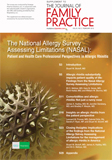User login
Today, virtually all physicians working in primary care will have a significant caseload of patients with allergic rhinitis (AR). Yet many physicians still regard AR as a relatively unimportant “nuisance” illness and only treat the symptoms on an as-needed basis. Likewise, many patients do not realize that effective treatments are available that can help control their condition and assume that they just have to live with their symptoms. Besides causing troublesome nasal symptoms, AR is associated with an increased risk of conditions such as asthma, rhinosinusitis, and chronic otitis media. In many areas of medicine, there is often a significant mismatch between the way a patient and physician view the illness in question. It is therefore important that physicians treating AR understand the patient perspective and take it into account when planning long-term management of the patient’s symptoms. This supplement presents results from the Nasal Allergy Survey Assessing Limitations (NASAL), which provides an up-to-date assessment of symptoms, burden of disease, and patient and provider perspectives concerning AR and nasal allergy treatment in the United States.
Today, virtually all physicians working in primary care will have a significant caseload of patients with allergic rhinitis (AR). Yet many physicians still regard AR as a relatively unimportant “nuisance” illness and only treat the symptoms on an as-needed basis. Likewise, many patients do not realize that effective treatments are available that can help control their condition and assume that they just have to live with their symptoms. Besides causing troublesome nasal symptoms, AR is associated with an increased risk of conditions such as asthma, rhinosinusitis, and chronic otitis media. In many areas of medicine, there is often a significant mismatch between the way a patient and physician view the illness in question. It is therefore important that physicians treating AR understand the patient perspective and take it into account when planning long-term management of the patient’s symptoms. This supplement presents results from the Nasal Allergy Survey Assessing Limitations (NASAL), which provides an up-to-date assessment of symptoms, burden of disease, and patient and provider perspectives concerning AR and nasal allergy treatment in the United States.
Today, virtually all physicians working in primary care will have a significant caseload of patients with allergic rhinitis (AR). Yet many physicians still regard AR as a relatively unimportant “nuisance” illness and only treat the symptoms on an as-needed basis. Likewise, many patients do not realize that effective treatments are available that can help control their condition and assume that they just have to live with their symptoms. Besides causing troublesome nasal symptoms, AR is associated with an increased risk of conditions such as asthma, rhinosinusitis, and chronic otitis media. In many areas of medicine, there is often a significant mismatch between the way a patient and physician view the illness in question. It is therefore important that physicians treating AR understand the patient perspective and take it into account when planning long-term management of the patient’s symptoms. This supplement presents results from the Nasal Allergy Survey Assessing Limitations (NASAL), which provides an up-to-date assessment of symptoms, burden of disease, and patient and provider perspectives concerning AR and nasal allergy treatment in the United States.
